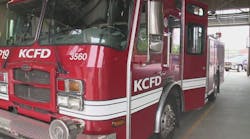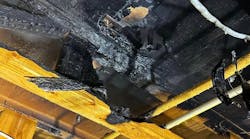Just about a month ago in December, the USFA National Fire Data Center NFDC released "Fire in the United States, 2003-2007" report.
This document is the 15th major edition of "Fire in The United States" published by the USFA and covers the five year period of 2003 to 2007 with a primary focus on 2007. The first edition was published in 1978, and included fire data from 1975 and 1976.
The good news is that the national fire loss statistics continued on a downward trend. The report indicates that annual deaths from fire in the United States were estimated at 12,000 in 1974, the year in which the USFA was established.
The NFPA estimated fire deaths in 2007 was 3,430.
Yet despite all the improvements during the past three decades, the report indicates that "nevertheless, the United States has a fire death rate 2 to 2 1/2 times that of several European Nations and at least 20 percent higher than many other nations. Of the 25 industrial nations examined by the World Fire Statistics Centre, the United States ranked as having the fifth highest fire death rate. This general status has been unchanged for the past 27 years."
No, that isn't the bad news either. It is rather important for us to be aware of such global statistics and comparisons since they help us better realize where we truly stand, recognize the shortcomings, and point out to the areas that we need to focus to do even a better job in the future.
We have come a long way indeed. But the journey is not over. We still have a long way to go. In my mind, the issue isn't whether the glass is half full or half empty. It is simply about what we in the fire service can do better, where we can improve to provide a higher level of fire protection for our local communities, and how we can best address the fire problem in our country.
On page one of the report, the depth of our national fire problem is clearly depicted in the very first paragraph of the executive summary section, which states:
"Fire departments in the United States responded to nearly 1.6 million fire calls in 2007. The United States fire problem, on a per capita basis, is one of the worst in the industrial world. Thousands of Americans die each year, tens of thousands of people are injured, and property losses reach billions of dollars. There are huge indirect costs of fire as well-temporary lodging, lost business, medical expenses, psychological damage, and others. These indirect costs may be as much as 8 to 10 times higher than the direct costs of fire. To put this in context, the annual losses from floods, hurricanes, tornadoes, earthquakes, and other natural disasters combined in the United States average just a fraction of those from fires. The public, the media, and local governments generally are unaware of the magnitude and seriousness of the fire problem to individuals and their families, to communities, and to the Nation."
Here lays the problem. While it is true that the public, the media, and local governments generally are unaware of the magnitude and seriousness of the fire problem to individuals and their families, to communities, and to the nation. I sincerely believe that the same exact lack of awareness also exists among our very own peers in the fire service.
Don't take my word for it, check it out for yourself. Never mind the young rookie firefighters who haven't been around long enough to know, but ask any/all of your best seasoned, most senior chief officers in your departments to see whether they were even aware that the annual losses from floods, hurricanes, tornadoes, earthquakes, and other natural disasters combined in the United States average just a fraction of those from fires.
Forget about asking them about the annual fire loss statistics in the country, or yet even closer in your own state. Ask them if they know the annual fire loss statistics in your very own community. What did you find out?
The intent of those questions was not to put our chief officers on the spot. But to point out that we in the fire service are so focused on the trees, that we don't see the forest. Our attention is merely focused on our own day-to-day operations, that at best we might only have a general idea about our own local fire loss statistics.
Regrettably, most of us are not even aware of our own state's statistics, let alone the national fire loss statistics.
Now, if we don't know the true magnitude and seriousness of the national fire problem, how in the world are we going to explain it to the public, the media, and the local government?
And that my friends, is a significant obstacle that we must overcome, both at the local and at the national levels.
Let me put it this way. At a fire, if we haven't done a good complete 360-degree size-up, we won't know the extent and magnitude of the problem. It is only when we have an accurate assessment of the immediate challenges that we can call for the adequate resources to address them, right?
Quite similarly then, if our public and elected officials are truly unaware of the seriousness and the real magnitude of the fire problem, then how do we expect them to provide us with the necessary resources to address it?
In my mind then, having a valid, detailed, and accurate national database that can provide us with up to date local, state, and national fire loss statistics, is of utmost importance to all of us in the fire service. And that was the main reason that the USFA developed the National Fire Incident Reporting System (NFIRS) back in 1976.
Version 5.0 of NFIRS was developed back in 1999 and is currently in use. Major changes to the NFIRS system are in development, with a web-based input tool to be released in the first quarter of 2010, and a new data warehouse with improved output report capabilities to be released early in 2011.
The "Fire in the United States, 2003-2007" report indicates that NFIRS was the primary source of data and accounted for 98 percent of the fire incident data reported. This document then, in a sense, could be considered our recent report card. Analyzing some of its findings could be of significant value to us in the fire service and could assist us in identifying our shortcomings and improving our performance.
This document indicates that out of the estimated 33,784 fire departments in our country, only 20,022 of the departments (59%) reported to NFIRS in 2007. Why is it that all of the fire departments in our country do not report to NFIRS? Because participation is only voluntary, thus the other 41 percent don't feel obligated to report to NFIRS. And even this low level of participation is the highest ever and has increased significantly thanks for the provisions of the Assistant to Firefighters Grant (AFG) program that require applicants to be reporting to NFIRS!
Wow! Can you even imagine if only 59 percent of our counterparts in the law enforcement communities reported their local crime statistics into their national data base; and the remaining 41 percent just didn't feel like filling the reports, or claimed that they didn't have the time and/or expertise to participate in the program? They have abundant up-to-date, detailed, and complete national and local crime statistics. That helps them justify their needs assessments, and obtain their necessary resources during good economic times or bad, whether the crimes are up or down. And the best that we can do is only 59 percent? Why?
Here is the difference. Their rookies get two to three weeks of detailed report writing courses that enhance their abilities and skills to write detailed, well-documented, meticulous reports that could be presented in courts and withstand all the cross examinations and all legal challenges. Arresting the criminals is not the end of their job -- it is only the beginning.
It is the quality of their documents and reports that finally wins their case and puts the criminals behind the bars. They know that if they take a little more time upfront, to cross all the "t"s and dot all the "i"s, that it will save them a lot more time and much headaches down the line, and make their case much stronger to obtain a conviction.
They recognize that it is their professional obligation to gather all the evidence and be very meticulous in their documentation. Simply stated, they know that it is their job. And of course, the fact that their detailed statistics help them obtain much needed local and national funding doesn't hurt either.
Many of the reports that police officers write document alleged crimes, including robbery and assault. These crimes result in property damage, loss of life, or injuries to the individuals. Senior police officials and the elected officials would not tolerate incomplete or sloppy police reports. Yet, although fires result in the same consequences of property damage or, in some cases, loss of life or injuries as previously mentioned, in comparison our documentation and reporting is rather sloppy and many NFIRS reports don't completely tell the story of the incident. Why? Unfortunately, such deficiencies are tolerated by our leadership. We need a cultural shift, and we must evolve professionally.
For most, we are just there for the thrill of fighting the fires. And once the fire is out, we consider our job done. Wrong! Let's face it; even the salvage and overhaul operations seem to be not too glamorous and less than desired, let alone the boring task of completing the paperwork.
We don't value report writing much, and we spend little or no time in training our rookies. And no, our newly promoted officers don't get much training either. For most, here are the books now get busy and start writing is the only guidance and their first exposure to report writing. So what do we expect then?
At best, their efforts might be adequate for their local demands. But then they simply "wing it" when submitting the NFIRS reports, just to get it done and out of their hair. After all, they don't see any direct positive value in all those statistics and reporting to the Feds. To them all those national reports are dumped into an abyss in the twilight zone, never to be found. There is nothing in it for them, other than the time spent in writing the reports.
They don't see any substantial values for their efforts, thus even their submitted reports might not be fully complete, valid, or even too accurate. Yet, if they truly recognize the benefits and the value of the NFIRS to them and their local jurisdictions, then the little effort and the additional time that goes in completing a valid and accurate report would certainly be worth it.
After all, there are only 11 modules in NFIRS 5.0, and besides the Basic Module (NFIRS-1) that must be filled for all incidents, only four modules (fire, structural fire, civilian fire casualties, and fire service casualties) are required to be filled, and the other six modules (EMS, hazardous materials, wildland fire, apparatus/resources, personnel, and arson) are only optional to be filled and submitted. And to make it even easier and simpler to submit, in all the forms for those required modules, there are only a certain number of required fields that must be filled. Seriously my friends, how difficult could it really be to do it right?
Yet, the quality of the submitted reports to the NFIRS is an area of great concern for the USFA. The following excerpts from the "Fire in the United States, 2003-2007" document these concerns and the deficiencies that must be improved:
"Data challenges still exist: many records submitted to NFIRS by participating fire departments provide either incomplete or no information in some of the fields. Additionally, in preparing this report, it is assumed that participating fire departments have reported 100 percent of their fire incidents; however, this is not always the case. The completeness of all the information in the NFIRS modules will contribute to the refinement and confidence level of future analyses.
On a fraction of the incident reports or casualty reports sent to NFIRS, the desired information for many data items either is not reported or is reported as "unknown." The total number of blank or unknown entries is often larger than some of the important subcategories. For example, 43 percent of fatal structure fires reported in 2007 do not have sufficient data recorded in NFIRS to determine fire cause. The lack of data, especially for these fatal fires, masks the true picture of the fire problem. Many prevention and public education programs use NFIRS data to target at-risk groups or to address critical problems, fire officials use the data in decision-making that affects the allocation of firefighting resources, and consumer groups and litigators use the data to assess product fire incidence. When the unknowns are large, the credibility of the data suffers. In some cases, even after the best attempts by fire investigators, the information is truly unknown. In other cases, the information reported as unknown in the initial NFIRS report is not updated after the fire investigation is completed. Fire departments need to be more aware of the effect of incomplete data reporting and need to update the initial NFIRS report if additional information is available after investigation.
As troublesome as insufficient data for the various NFIRS data items can be, equally challenging is the apparent non-reporting of injuries and property loss associated with many fire incidents. For example, there are many reported fires where the flame spread indicates damage but property loss is not reported. It is notoriously difficult to estimate dollar loss, but an approximation is more useful than leaving the data item blank. The degree to which there is incomplete reporting of civilian fire deaths is more difficult to identify, as the numbers of deaths are relatively small. Incomplete reporting of civilian injuries also is difficult to ascertain, but the injury-per-fire profiles for most departments are within reason."
Let's face it, the fault rests with us, and not the NFIRS or the USFA. We have a great tool available to us that can best describe our challenges and gallant efforts. It can clearly depict our needs both at the local and at the national levels to assist us with obtaining the desperately needed resources, and yet we don't utilize it the best that we should. My friends, we are just shortchanging ourselves.
All those "undetermined" causes that are marked on the Fire Module (NFIRS-2), just to get it done, don't help us at all to address the fire problem. When we "wing it" and merely "guesstimate" the dollar losses and values on the Basic Module (NFIRS-1), we are only skewing the data.
We need accurate information in the code development arenas to make sure that the buildings constructed have fire and life safety provisions that can protect our citizens and our firefighters. Why is that important? Because the USFA report clearly points out that the 3 Es of fire prevention (engineering, education, and enforcement) played a key role in reducing our fire losses. Take a look, and you can see that, based on the report, five out of the six factors that directly contributed to these downward fire trends were directly related to fire prevention.
"This report shows that, overall, the fire problem in the United States continues to improve. Five-year fire loss rates are down. It is likely that several factors continue to contribute to these trends:
- Smoke alarms, whose usage has become nearly universal;
- Sprinklers, which quickly combat incipient fires, especially in nonresidential and multifamily buildings;
- Fire codes, which have been strengthened;
- Construction techniques and materials, which have been targeted specifically to fire prevention;
- Public education at the community, county, State, and Federal levels; and
- Improved firefighter equipment and training."
To continue this positive trend and to be able to further reduce our national fire loss statistics through our fire prevention efforts, we need detailed statistics. But then, how can we enhance the codes and improve our performance without detail statistics pointing to the roots of the fires. Do you know how many times we were defeated in the code development arenas because we didn't have adequate data and statistics to prove our case? It took us a couple of decades to finally get residential fire sprinklers in the codes.
Under the current circumstances and with their limited resources, the USFA and the NFDC are doing the best that they can to help us depict the local and the national fire problem for our public. Sure, they might be able to further tweak and improve the NFIRS. But, it is entirely up to us at the local levels to recognize the true value of NFIRS as a great tool to clearly tell our story and explain our needs assessments to our public.
The problem is not as much with the system as with our very own traditional and cultural stance and philosophy toward report writing, especially when it comes to sending complete, valid, and accurate reports to the NFIRS. We need a cultural shift. One that reminds us once again, that it is our job to be meticulously documenting and accurately reporting all of our incidents to NFIRS.
The saying "the job is not done until the paperwork is done" is absolutely right. It is our job to keep good records. It is our job to report valid, detailed, and accurate statistics. It is our job to make sure that not only the mandatory fields on the NFIRS modules are filled completely and accurately, but that all of the other fields are answered accurately also. Would that be above and beyond what NFIRS currently requires? Certainly, but then who benefits from those detailed reports and statistics after all?
No one but us. It gives us the clearest picture of the fire problem in our communities. It gives us the detailed statistics to justify the needs assessments and the budget requests to the decision makers and politicians in our own jurisdiction. In this great economic recession that we are experiencing, won't those types of detailed reports and statistics give us more ammunition and assist us in proving our case?
In my mind, there is absolutely no reason that we can't have all departments across the land report to NFIRS. Lack of manpower and resources is just an excuse.
First of all, the volume of calls in those little communities with volunteer departments is rather small and manageable. And it isn't like they are so busy running on calls that they don't get a chance to do a good job of reporting. It is just that they have not yet fully realized the benefits of NFIRS. Therefore reporting to NFIRS is not at the top of their priority list. Especially since they are volunteers and have their own jobs that they must attend too.
But even for that, there is a simple solution. When there is a will, there is a way. At this day and age that computers are available to almost all, and internet has conquered the entire globe where even the small villages in the third world countries have access to the internet, it is inexcusable to claim that we don't have the expertise in our small town volunteer fire departments to fill the NFIRS reports online.
I doubt that there is any little volunteer fire department that could not find a young and enthusiastic Explorer in their own town that won't be willing to help out their local fire department with their documentations and NFIRS reporting. They can even find an older, retired fire buff through the citizens Fire Corps program that would love to serve their local community in such capacity. And, rest assured that they would feel honored and would take pride to do a meticulous and exemplary job.
A complete, detailed, and accurate data base like NFIRS would benefit our communities at the local level, in addition to helping us better identify the trends and solutions to address our national fire problem. Anyone disagree? Then why not take the time to do it right?
We must recognize that good documentation and reporting is an important part of our job that must be performed well. This is an essential cultural shift that the fire service needs to make to step into the 21st century.
Here is an idea that can sweeten the deal for the local volunteer fire department to embrace this cultural shift. How about if USFA could establish an incentive program through the Assistant to Firefighters Grant (AFG) program that could provide a small grant as a financial incentive to the volunteer departments that submit complete, valid, and accurate NFIRS reports every year?
USFA could either administer it directly or through the 50 state fire marshals offices to distribute the grants to those volunteer departments in their states. How about that? It sure can't hurt and can even make more than all the bake sales, fireworks, and all the other fundraising functions that these small volunteer fire departments must do year after year to generate revenue for their operations. That could work for the combination fire departments also.
That being said, there is absolutely no reason in my mind that any career fire department in our country could not fully participate in the NFIRS. I believe that there must be a quality control mechanism in all of the career fire departments, and their standard operating procedures must be specifically tailored to ensure that high quality, consistent, complete, valid, and accurate reports are submitted to the NFIRS every single year.
Maybe an administrative chief officer could be assigned to these quality control responsibilities to make sure that not just the few required fields, but all of the fields in the NFIRS forms are consistently, accurately, and completely filled and submitted. They would then be the point of contact with the state and the national NFIRS.
Here is another idea for institutionalizing the cultural shift in the career fire departments. USFA's requirement to have all recipients of the Assistant to Firefighters Grant (AFG) program participate in the NFIRS has worked great, and the number of participating departments has almost doubled between 2000 and 2007.
They should continue with that requirement. But make it even a little more stringent for the career departments, and require them to submit fully completed reports. Simply put, the career fire departments should forget about the little star (*) on the side of the questions on the forms that designate the required fields. The career fire departments must answer all of the questions and fill out the form completely if they want to be a recipient of the AFG.
Is that too much to ask? I don't think so. After all the NFIRS modules are only a page or two long, and all of the questions on them are quite valuable to accurately depict the nature and the extent of the incidents. If those questions were absolutely useless and irrelevant, they wouldn't have been put there in the first place, right? Those questions help us collect accurate data that serves us in addressing the national fire problem. And yet most importantly and even more directly, it helps the local fire departments to justify their needs and the services they provide to their own local decision makers and politicians.
Money talks, my friends. So, let's use an incentive/disincentive program to institutionalize this cultural shift and get all of the fire departments across our land to participate in the NFIRS program, rather than the current 59%. Yes, participation in NFIRS is only voluntary and not mandatory, but then we must fully participate because our professional obligations demand that. Yet, you surely agree that a little good old fashion incentive program won't hurt to boost up that spirit of voluntarism and encourage better participation either.
As I have mentioned, NFIRS is a great data base and the USFA and NFDC should take pride in their work. However, I believe that more work must be done to keep the statistics more up to date. The "Fire in the United States, 2003-2007" document states that "because of the time it takes for States to submit data to USFA from the thousands of fire departments that participate in NFIRS, then obtain corrections and edit the data, and analyze and display the results, the publication lags behind the date of data collection. Fortunately, the fire problem does not change very rapidly, so the data usually are quite representative of the situation in the year of publication as well."
I agree with that statement to a certain extent. Yes, the fire problem does not change rapidly and even this less than precise set of data is still relevant. But let's face it, in this day and age of instant global communication, don't you think that there is something lagging when our latest and greatest fire loss document that was just released in December of 2009 is talking about the 2007 data?
Seriously, how accurate could our current fire problem information be when we are talking about statistics from three years ago, way before our latest economic depression showed its ugly head and crippled all of our communities across the land? How many of our fire departments have the same level of resources and staffing as they had three years ago? What about the adverse impact of all these brown outs, station closures and firefighters layoffs, all while lot of the housing foreclosures and closed off businesses are set to burn?
Are our fire problem trends the same? Sure, for the most part yes. For example, just as it has been for decades, we lose about 80% of our fatalities in home fires. Does it justify us saying that since the fire problem is basically the same, then let's just forget about collecting data for the NFIRS annually and do as the Census does and collect statistics every ten years?
No, at this day and age, we need a lot more than just a silhouette image. We need a detailed and accurate picture of the fire problem. NFIRS must be designed to be up to date and be capable of providing us with the updated data and statistics that could assist us in our day to day battles in our local jurisdictions. And this is exactly the area where NFIRS needs to improve to better help us at the local level.
For example, take a look at the field G2 on the Basic Module (NFIRS-1) where the estimated dollar losses and values are entered. If there was a field created there right after the "Losses" and "Pre-Incident Value", that could automatically fill (by deducting the losses from the pre-incident value) to show the estimated dollar value saved, wouldn't that be a great indication of the value of our service to our community? I mean, for a single incident for example, if the pre-incident value was $500,000, and the fire losses were $70,000, then that would show that the savings due to our efforts was $430,000 for that incident alone. Add that up for all your incidents in one year and that could be a good depiction of your department's value to your jurisdiction. Can that come in handy during the budget hearings?
During this tough economic climate in all our jurisdictions across the land, we are forced to fiercely compete for the very scarce resources. And to be successful, we need detailed, accurate statistics clearly depicting the magnitude of the problem and the required resources. Gone are the days that simple emotional presentations were adequate to get us an annual five percent budget increase year after year. In this day and age of instant global communication and information to the point of saturation, statistics from three years ago don't do us much good. Let's face it, to be successful with the decision-makers and politicians, we need current statistics.
Fires are just a small percentage (6.1 percent based on the NFPA statistics) of the incidents to which fire departments respond. We are all aware that the majority of our time is spent providing EMS to the public. Many fire departments also provide specialized services including hazmat response, specialized rescue, and wildland fire resources. Some departments even provide other public services in their communities such as doing blood pressure screening, accident prevention, bicycle safety, or other fire and life safety education. We may do all these services, but do we fully document these activities? My friends, detailed documentation of all our services and meticulous reporting of all our daily activities is even more essential now than ever before.
All of us in the fire service, whether career, combination, or volunteer departments, are fighting to survive during these massive budget cuts. In all municipalities, we are fighting for the same shrinking dollars. And the only way to compete with the other municipal departments and agencies for these dollars is to be able to meticulously justify our needs. We must do this ourselves as no one will do it for us. Complete NFIRS reporting will put us on an even playing field with all those agencies with whom we are competing for funding. We must recognize that accurate NFIRS reporting helps us all at the local levels.
I am not at all familiar with the law enforcement data collection system and their data base. But I have heard that it is a lot more centralized and up to date than ours. It might be of value if the USFA could take a look at some of the capabilities of their systems to see if or where they could be tailored to fit our needs. And if suitable, they might then work on updating their technical specifications for the software upgrades for NFIRS.
The technology for the up to date data is available in the private sector side. The insurance companies have detailed statistics that they use for their own internal use. And they even have simplified interactive forms of it available for their customers use. For example, take a look at this link from the Allstate Insurance website. This Allstate web site is called "The most common and costly claims." This program allows anyone to enter a zip code, and it will list the five most common claims and the most costly claims.
This was just an example, but I am sure that the technology is available to have similar detailed fire statistics available to us all in our own jurisdictions. Why can't we have an interactive website like this available for the fire service? Can you imagine how useful something like this could be to all of us during budget presentations in our own local jurisdictions? You can show to every one of your councilmen/women or your District Board members the exact loss statistics in their wards, and explain your needs and resources to better serve your community.
The USFA report stated that "with continued improvements to the NFIRS system, data collection will also continue to improve. If we better understand the relative importance of the factors that lessen the fire problem, resources can be better targeted to have the most impact." That is absolutely right. My friends, the proof is in the pudding. NFIRS is the best tool available to us to clearly tell our story and help us with our efforts to address the fire problem in our country. It is up to us to enhance it, and make sure that it continues to be the most accurate and up to date fire data base in the world.
AZARANG (OZZIE) MIRKHAH P.E., CBO, EFO, CFO, MIFireE, a Firehouse.com Contributing Editor, is the Fire Protection Engineer for the City of Las Vegas Department of Fire & Rescue. Ozzie served on the national NFPA 13 Technical Committee for Sprinkler System Discharge Design Criteria and serves on the IAFC Fire Life Safety Section Board of Directors. He was the first recipient of the IAFC's Excellence in Fire and Life Safety Award in 2007. Ozzie has participated in two Radio@Firehouse podcasts: Six Days, Six Fires, 19 Children and 9 Adults Killed and Fire Marshal's Corner. You can reach Ozzie by e-mail at [email protected].





